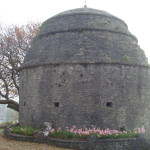The Dovecote at The Court is the most striking building on the site and probably the one that most people are aware of.
It is a large, domed building standing proud behind the limestone wall rising up from the old limestone workings that Gladstone Road passes through on its way to the Moors.
The building dates from the 13th Century. That makes it approximately contemporaneous with Magna Carta and Tintern Abbey, older than Caerphilly Castle but a tad younger than Cardiff Castle. It may be slightly older than Barry Castle – but clearly in better condition.
There are many Dovecotes preserved around England and Wales. They are believed to have been introduced initially by the Romans and then the French following the defeat of Harold in 1066. They were used, as the name implies, to house Doves. These were a delicacy enjoyed by the rich for many centuries. In fact you had to have a certain status to be allowed to own a Dovecote. In all probability when this Dovecote was constructed ownership was limited to the nobility by way of droit de colombier; they were a symbol of status and power and were regulated by law. This supports the view that at this time the owners of this site were very well connected, were rich and well respected. In all probability the building of the Dovecote at the spot chosen was a declaration by the Norman owners of their wealth and status.
The building is in the columbarium style with a corbelled stone dome. Put another way the Dovecote is constructed with many breeding holes around the walls (originally probably at least 700) with a roof that is carefully constructed with well chosen small stones to form a roof where the stones support each other. A method of construction of roofs going back to at least 5,000BC.
The keeping of Doves was simple. Once the Dovecote was set up with the breeding pairs they tended to look after themselves save in harsh winters. The birds were an important source of meat with the young birds being prepared for the table when about 4 weeks of age, at a tender stage. With breeding pairs producing up to 7 pairs of chicks per annum this was a very useful way of supplying meat for the table. The birds were also useful for their feathers and down, used to stuff pillows and beds while the dung produced by the doves did wonders for the garden.
